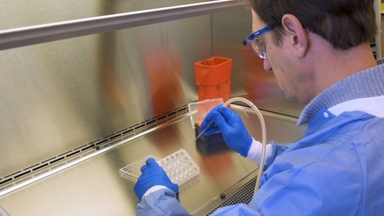A Permeable Membrane Insert-Based Infection System to Study the Impact of Bacterial Toxins
Transcript
Take a two-chambered infection system separated by a permeable membrane insert. The bottom compartment contains adherent human keratinocytes, or skin cells.
Add bacterial pathogens in the upper chamber, and incubate. The membrane prevents direct contact of the pathogens with the keratinocytes. Pathogens secrete streptolysin S or SLS — a small toxin — that crosses the membrane to reach the cells.
The sodium bicarbonate co-transporter on keratinocytes mediates the influx of bicarbonate and sodium ions, maintaining intracellular pH. SLS binds to the co-transporter and disrupts ion transport, leading to intracellular osmotic stress.
The stress-induced downstream signaling causes degradation of the inhibitor bound to sequestered Nuclear Factor-Kappa B, or NF-κB, leading to its activation. The activated NF-κB translocates to the nucleus, leading to the upregulation of pro-inflammatory cytokine production.
Upon extracellular secretion, the cytokines bind to death receptors on the host cell, initiating necrosis. Post-incubation, harvest the culture supernatant to assess the impact of the bacterial toxin.
Related Videos

Identification of Host Pathways Targeted by Bacterial Effector Proteins using Yeast Toxicity and Suppressor Screens

Human Colonoid Monolayers to Study Interactions Between Pathogens, Commensals, and Host Intestinal Epithelium

Deciphering the Molecular Mechanism and Function of Pore-Forming Toxins Using Leishmania major
ABOUT JoVE
Copyright © 2024 MyJoVE Corporation. All rights reserved